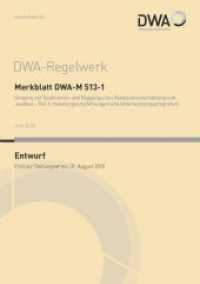Full Description
Updated and expanded, this second edition of "Fluid and Electrolyte Balance" presents current and comprehensive scientific information in the context of the nurses role in a clinical setting. It covers basic concepts, pathophysiology, assessment of fluid and electrolyte balance, considerations of major disturbances and principles of fluid therapy. New features of this edition include details of the pathophysiology of common causes of third-space fluid shifts; therapies to reduce fluid volume excess; nursing responsibilities in the administration of colloids and blood; the needs of tube-fed patients; perioperative imbalances; and the effect on fluid balance of bowel preparations used for diagnostic tests. The specific needs of the old and young are also covered. This text is aimed at medical and surgical nursing practitioners, students and intravenous therapists.
Contents
Part 1 Basic concepts: fundamental concepts and definitions; nursing assessment. Part 2 Overview of fluid and electrolyte problems - nursing considerations: fluid volume imbalances; sodium imbalances; potassium imbalances; calcium imbalances; magnesium imbalances; phosphorus imbalances; acid-base imbalances. Part 3 Principles of parenteral fluid therapy: intravenous therapy; parenteral fluids; total parenteral nutrition. Part 4 Clinical situations associated with fluid and electrolyte problems: tube feedings; fluid balance in the surgical patient; cirrhosis and ascites; gastrointestinal problems; acute pancreatitis; renal failure; heart failure; fluid balance in the head-injured patient; diabetic ketoacidosis and hyperosmolar coma; major thermal injuries; pregnancy; oncologic conditions. Part 5 Special considerations in children and the elderly: fluid balance in infants and children; fluid balance in the elderly patient.








